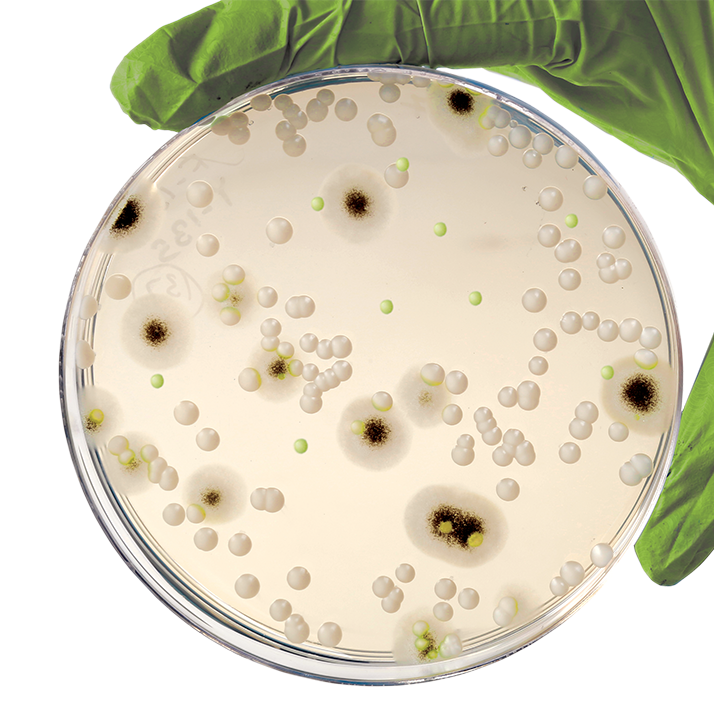Isolation and identification of mucormycosis-causing fungi from patient samples.
Mucormycosis (also called zygomycosis or black fungus) is a serious but fortunately relatively rare fungal infection caused by a group of molds in the zygomycete family. Mucormycosis diagnostics are usually based on the cultivation and identification of the pathogen.
For healthy people with a functioning immune system, the filamentous fungi do not actually pose any danger. The situation is quite different for immunocompromised or immunodeficient people. Individuals with acute leukemia (mostly children) and patients who suffer from diabetic ketoacidosis, take high doses of corticoids, or have received an organ or stem cell transplant are particularly affected by mucormycosis. Mucormycosis may also occur as a result of severe COVID-19 disease. This has been seen recently in India, where the number of cases has increased extremely with the recent Corona wave and mycomycosis now is causing additional incredible suffering.
Depending on how the fungus entered the body and which organ/tissue is affected by the infection, different forms of mucormycosis disease occur. All are life-threatening and have a more or less poor prognosis.
A quick and clear diagnosis of the disease is essential in order to offer patients the prospect of a cure. The diagnosis is primarily made by biopsy (sterile removal of a tissue sample), identification of the pathogen through the creation of a fungal culture, microscopy and/or histopathological evidence.
HiMedia offers a comprehensive range of products for mucormycosis diagnostics: culture media and antimycotics for the isolation of fungi from patient samples and subsequent antimycotic profiling.
Powder media for the isolation of mucormycosis pathogens
Cultivation / Propagation
- GM063 Sabouraud Dextrose Agar, Granulated
- MV063 Sabouraud Dextrose HiVeg™ Agar
- MCD063 Sabouraud Dextrose HiCynth™ Agar
- M096 Potato Dextrose Agar
- GM096 Potato Dextrose Agar, Granulated
- MCD096 Potato Dextrose HiCynth™ Agar
- M842 Rose Bengal Agar Base
- GM842 Rose Bengal Agar Base, Granulated
- M1467 HiCrome™ OGYE Agar Base
Antifungal Susceptibility Testing Resources for Mucormycosis Fungal Pathogens
![Amphotericin HiComb™ MIC Modified [MDM071, Bereich 0,002 - 32 μg/ml]. Amphotericin HiComb™ MIC Modified [MDM071, Bereich 0,002 - 32 μg/ml].](https://files.neofroxx.com/neoFroxx_Image_Mucormycosis_3-1-330x330.png)
Antifungal Ezy MIC™ Strips
- EM071 Amphotericin B Ezy Mic Strip (0.002-32 µg/ml)
- EM122 Anidulafungin Ezy Mic Strip (0.002-32 µg/ml)
- EM119 Caspofungin Ezy Mic Strip (0.002-32 µg/ml)
- EM144 Clotrimazole Ezy Mic Strip (0.002-32 µg/ml)
- EM072 Fluconazole Ezy Mic Strip (0.016-256 µg/ml)
- EM118 Flucytosine Ezy Mic Strip (0.002-32 µg/ml)
- EM143 Griseofulvin Ezy Mic Strip (0.002-32 µg/ml)
Antifungal HiComb™ MIC Test
- MD071 Amphotericin B HiComb MIC Test (Part A: 32-0.25 µg; Part B: 0.256-0.002 µg)
- MD072 Fluconazole HiComb MIC Test (Part A: 256-2 µg; Part B: 2.048-0.016 µg)
- MD074 Ketoconazole HiComb MIC Test (Part A: 32-0.25 µg; Part B: 0.256-0.002 µg)
- MD073 Itraconazole HiComb MIC Test (Part A: 32-0.25 µg; Part B: 0.256-0.002 µg)
Antifungal Sensitivity Discs
- SD111 Amphotericin B, 100 units
- SD233 Amphotericin B, 20 µg
- SD270 Amphotericin B, 50 µg
- SD115 Clotrimazole, 10 µg
- SD114 Fluconazole, 10 µg
- SD221 Itraconazole, 10 µg
- SD276 Itraconazole, 30 µg
- SD224 Ketonazole, 10 µg
- SD275 Ketonazole, 30 µg
- SD274 Ketonazole, 50 µg
- SD273 Miconazole, 30 µg
- SD272 Miconazole, 50 µg
- SD025 Nystatin, 100 units
- SD271 Nystatin, 50 µg


![Amphotericin Ezy MIC™ Strip [EM071] Amphotericin Ezy MIC™ Strip [EM071]](https://files.neofroxx.com/neoFroxx_Image_Mucormycosis_4-337x330.png)
![Ketoconazol Single Disc [SD275] Ketoconazol Single Disc [SD275].](https://files.neofroxx.com/neoFroxx_Image_Mucormycosis_2-3-370x310.png)